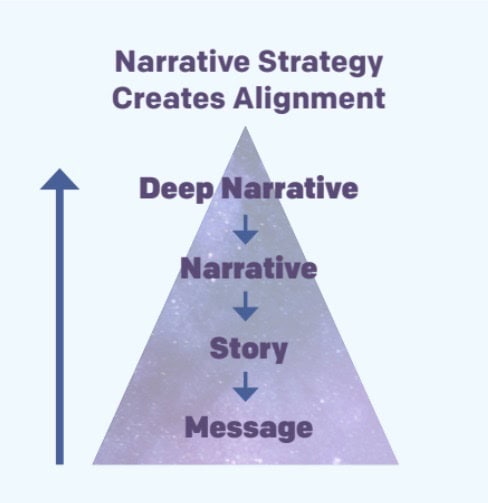
Glossary of Terms | Lab Update
Below is a list of terms and their definitions, as used throughout the Lab:
Message: Hashtags, slogans, ideas, and taglines that serve as reminders of what we think and how we might choose to act. They are most often used in the context of campaigns and strategic communications. The best of them become narratives. [1]
Story: Story is an account of an event or incident. It has discrete elements and building blocks such as characters, settings, conflicts, and actions that unfold over an arc and through a plot. Human brains are wired to interpret and create meaning through stories. Storytelling is a widely-used communication technique to connect with different audiences. [1]

Narrative: An array of related and connected stories and messages on a particular subject, issue, or problem. Narratives suggest causes, problems and solutions. We interpret stories and messages through them. They evoke emotion, offer analysis, and suggest action; they tell us how we should feel, think, and act. Narrative is the level at which society moves. “Black Lives Matter ” and “Love is Love ” are examples of narratives. These narratives tell us how we should understand equality and justice in relation to the experiences of Black and LGBQT+ communities. [1]
Deep Narrative: Deep narratives are the subconscious ways we view the world and our purpose in it. They are core ideas about human nature and how we relate to the world around us. They inform our basic concepts of identity, community, and belonging. For instance, a deep narrative that may inform your views around government assistance may be either scarcity or abundance. If you view the government having limited resources, you may support the limiting of welfare. Conversely, if you view the government through the lens of abundance, you would be more supportive of social programs. [1]
Narrative System: A narrative system is a set of deep narratives or shared values that together describe the worldview a particular group wants to use to challenge the status quo. It is a tool that can be used to ground a narrative project as it allows for messaging alignment and connectivity across projects and movements. For instance, a group may identify “interconnectedness,” “abundance,” and “hope” as the guiding values they project in their narrative work. [1]
Narrative Change: This work rests on the premise that reality is socially constructed through narrative, and that in order to bring about change in the world we need to pay attention to the ways in which this takes place. At the individual level, narrative change focuses on influencing individuals’ attitudes/opinions in order in turn to influence public opinion more broadly. [2]
Cultural Strategy: Cultural strategy is a field of practice that centers artists, storytellers, media makers and cultural influencers as agents of social change. It is indispensable to social movement building because it leverages the catalytic and emotional power of culture and the arts to shift attitudes, behaviors, resources, narratives, and creates conditions for sustainable cultural change. [3]
Narrative Strategy: Narrative strategy is the use of research and strategic communication techniques (i.e. story-telling and value-based messaging) to move people toward a particular understanding or worldview. Movements often develop a narrative strategy to coordinate and enforce shared messaging across different issues. [1]
Narrative Power: Narrative power is the ability to use our stories, words and images to change the norms and rules society lives by. Narrative infrastructure is everything we have to build to do that reliably over time. Power is leveraging the presence of our issues to force real changes in the rules that shape society — the policies for how governments and corporations work. Narrative power building happens on two fronts: 1) changing the protagonists of the stories that shape society; and 2) building the power to remove harmful and inaccurate stories from influencing people. [4]
Pop Culture: The conversations, big ideas, major narratives, and immersive stories—films, TV shows, music, books, games, political speeches, journalism, and more— experienced by mass audiences of millions of people every day. [5]
Audiences: Narrative change projects must reach an audience to have an impact. That audience should be made up of people who are willing and open to spreading your message to others in an effort to rally support for the change you seek. [6]
Value: A person’s principles or standards of behavior; one’s judgment of what is important in life. [7]
Belief: An acceptance that a statement is true or that something exists. [8]
Attitude: A settled way of thinking or feeling about someone or something, typically one that is reflected in a person’s behavior. [9]
Worldview: A particular philosophy of life or conception of the world. [10]
References
[1] Chang, Jeff., Nayantara, S., Treibitz, J., Abdullah, S., and Hammon, K., “A Future for All of Us.” Butterfly Lab for Immigrant Narrative Strategy, https://www.raceforward.org/research/reports/future-all-us-report-phase-1-butterfly-lab-immigrant-narrative-strategy
[2] Davidson, Brett. “Narrative Change and the Open Society Public Health Program.” On Think Tanks, 20 July 2016. https://onthinktanks.org/articles/the-role-of-narrative-change-in-influencing-policy/ s. 26 July 2020, robfields.com/2020/07/26/defining-narrative-change/
[3] Potts, Erin. “A Conversation about Cultural Strategy.” Medium. 15 June 2018. https://medium.com/a-more-perfect-story/a-conversation-about-cultural-strategy-9e2a28802160
[4] Robinson, Rashad. “Narrative Power.“ Twitter thread, 23 November 2020. https://twitter.com/rashadrobinson/status/1331000573726916608 And, Robinson, Rashad. “Changing Our Narrative About Narrative.” Color of Change, April 2018. https://narrative.colorofchange.org/#report4
[5] Pop Culture Collaborative. “Pop Culture for Social Change Terms and Definitions” https://popcollab.org/learning/pop-culture-for-social-change-terms-and-definitions/
[6] “Audience Identification Worksheet.” Narrative Initiative. https://narrativeinitiative.org/resource/audience-worksheet/
[7] Merriam-Webster. “Definition of VALUE.” Merriam-Webster.com, 2019, www.merriam-webster.com/dictionary/value
[8] Webster, Merriam. “Definition of BELIEF.” Merriam-Webster.com, 2019, www.merriam-webster.com/dictionary/belief
[9] “Definition of ATTITUDE.” Merriam-Webster.com, 2019, www.merriam-webster.com/dictionary/attitude
[10] “Definition of WORLDVIEW.” Merriam-Webster.com, 2019, www.merriam-webster.com/dictionary/worldview